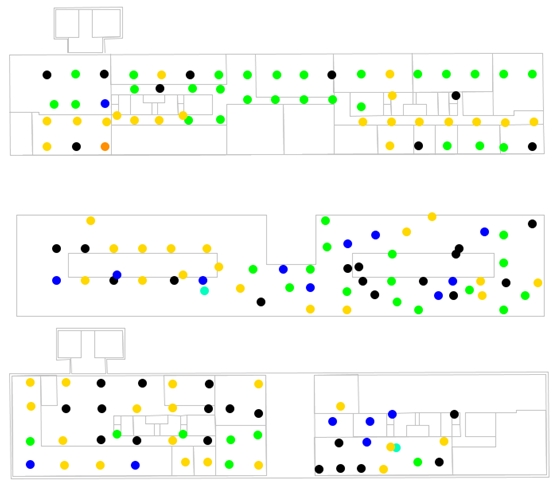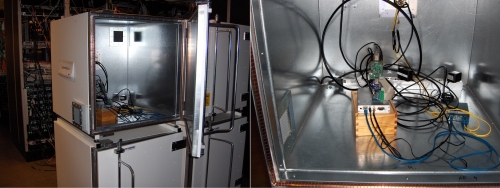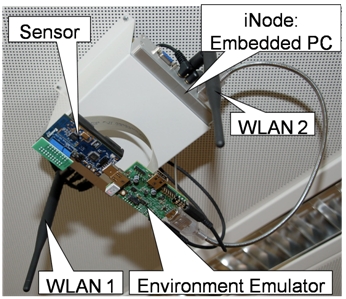w-iLab.t (iMinds)
Context
Wireless testbeds enable to effectively test the wireless protocols or applications in a real-life environment. In such an environment, the spectrum is not 'clean', and the locations of the nodes are fairly random. Current testbeds generally offer very limited flexibility in terms of application scenarios, node failure and the like, and are therefore not the ideal validation tools for real-life wireless network operation. Further, one of the major research issues in wireless networks is the development of energy efficient protocols in order to enlarge the lifetime of the nodes and thus the network. However, in existing testbeds it is not possible to measure the energy consumption of each individual node efficiently.
Screencast showing the basic functionality of the w-iLab.t testbed. Best viewed in fullscreen HD.
w.iLab.t testbed
The w-iLab.t testbed includes both a wireless mesh and sensor network infrastructure. These networks can interact with each other, making it possible to test advanced scenarios such as using the mesh network as a backbone for the sensor network. Further, interference between both networks can be studied. In order to facilitate the emulation of realistic sensor scenarios and to measure the energy consumption, the testbed is equipped with a custom designed hardware solutions, called the Environment Emulator (EE). Using the EE, it is possible to emulate the behavior of any type of sensor or actuator without the need for real sensor/actuator hardware or the development of a full-blown sensor application. It is possible to emulate the battery depletion, depending on the real life power consumption of the sensor node. When the node's battery is depleted or the node is destroyed (e.g., in an explosion), the node can be switched off. The EE can be programmed to emulate a sensor event (e.g., temperature rise, motion detection), an actuator event or to support voice streams. Further, the EE can be used to monitor the energy consumption of each individual sensor. Altogether, this means that it is possible to assess the complete usability of a certain wireless sensor and actuator network application or protocol in a real-life environment. The initial core of w-iLab.t was based on the widely used MoteLab testbed from Harvard University.
The iMinds w-iLab.t has two setups the "w-iLab.t Office" and the "w-iLab.t Zwijnaarde" and it is part of the larger iLab.t facility. The "w-iLab.t Office" consists of a wireless Wi-Fi (IEEE 802.11a/b/g) and sensor network (IEEE 802.15.4) testbed infrastructure, deployed across three 90 m x 18 m floors of the iMinds office building in Ghent, Belgium. At 200 places throughout the office spaces, meeting rooms and corridors, wireless hardware is mounted to the ceiling.
The "w-iLab.t Zwijnaarde" is equipped with 60 wireless nodes: IEEE 802.11a/b/g/n, IEEE802.15.4, IEEE802.15.1 (Bluetooth) interfaces, software defined radio platforms (USRP) and spectrum scanning engines developed by imec. In addition, it offers mobile nodes to the experimenters. These mobile nodes feature the same equipment as the fixed ones, however they are mounted on Roomba vacuum cleaning robot. This facility is located in Zwijnaarde, Belgium, approximately 5 km away from the "w-iLab.t Office".
Node locations of the w-iLab.t testbed

Map of the second floor.
Additionally, w-iLab.t is equipped with a shielded wireless environment. This environment is built up by 4 shielded boxes in which an iNode is installed. The iNodes are interconnected between the boxes by coax cables via a variable attenuator. By varying the signal attenuation, node mobility can be simulated in a repeatable way.

Left: RF shielded boxes. Right: iNode inside the box.
iNodes:
Every w-iLab.t node is generic and is equipped with one or more sensor nodes, an intermediate node with 2 WiFi 802.11 radios, the environment emulator and a Bluetooth interface.
The sensor nodes are Tmote Sky motes that use a Tiny OS development environment. They consist of a TI MSP430 processor running at 8MHz, 10KB of RAM, 1Mbit of Flash memory and an IEEE 802.15.4 compliant Chipcon CC2420 radio operating at 2.4GHz with a maximum indoor range of approximately 100 meters. Each node includes sensors for light, temperature, and humidity. The hardware setup is extendable with a large variety of other radios (e.g Software Defined Radio, sensing engine), as long as the radio has a USB or RS232 serial interface.
The intermediate nodes (called iNodes) are Alix 3C3 devices running Linux. These are mini PC's equipped with Ethernet, USB, serial, vga, audio and two IEEE 802.11 a/b/g interfaces. All the iNodes are connected to the management backbone using Power-over-Ethernet switches, making it possible to power up/down the iNodes as needed without physical interaction with the iNodes. The iNodes can become an active member of the experiment as it is possible to adjust the kernel, the driver, to add click router code or to add java-based applications.
Finally, the Environment Emulator is located in between the iNode and the sensor node.

iNode mounted to the ceiling.
Accessing the testbed
The w-iLab.t testbed is centrally managed for control and monitoring purposes. For getting started, request an account. Tutorials, documentation and other useful information is available here.
Contribution to CREW
The w-iLab.t testbed as well as new cognitive radio extensions will be made available in the federated testbed.












